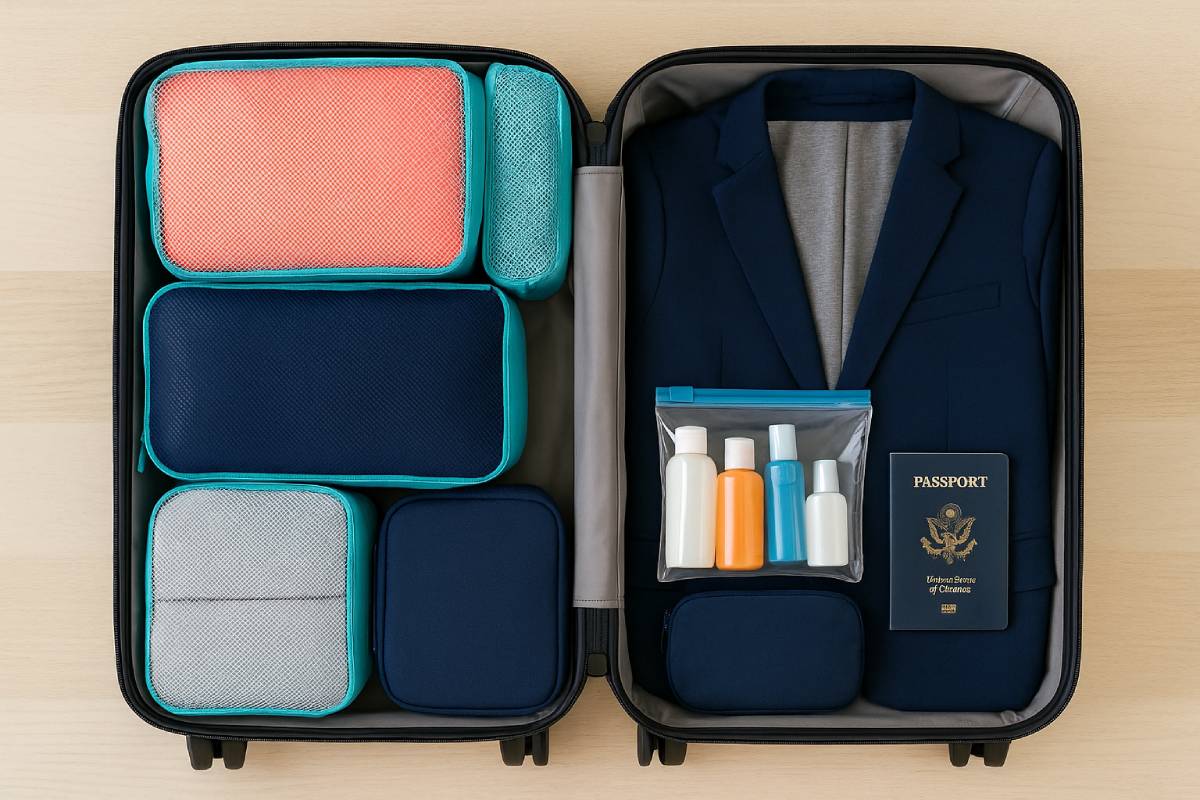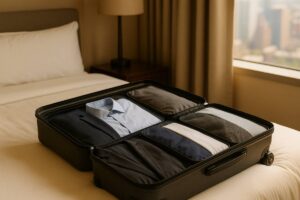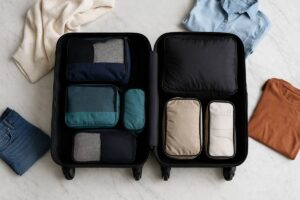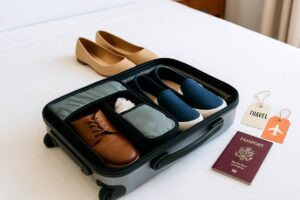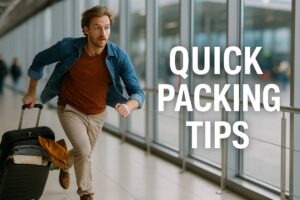Imagine breezing through check-in and security, your carry-on perfectly sized, liquids neatly contained, and every outfit instantly at hand—no more panicked searches at the gate.
With 52 % of global passengers opting for “carry-on only” travel, a strategic packing plan is no longer optional.
Following the IATA’s 56 × 45 × 25 cm cabin-bag guideline and TSA’s strict 3-1-1 liquids rule, you’ll discover how to fit everything from your passport to your portable charger (packed by 80.4 % of travelers) into one seamless carry-on.
Understanding Airline Carry-On Regulations
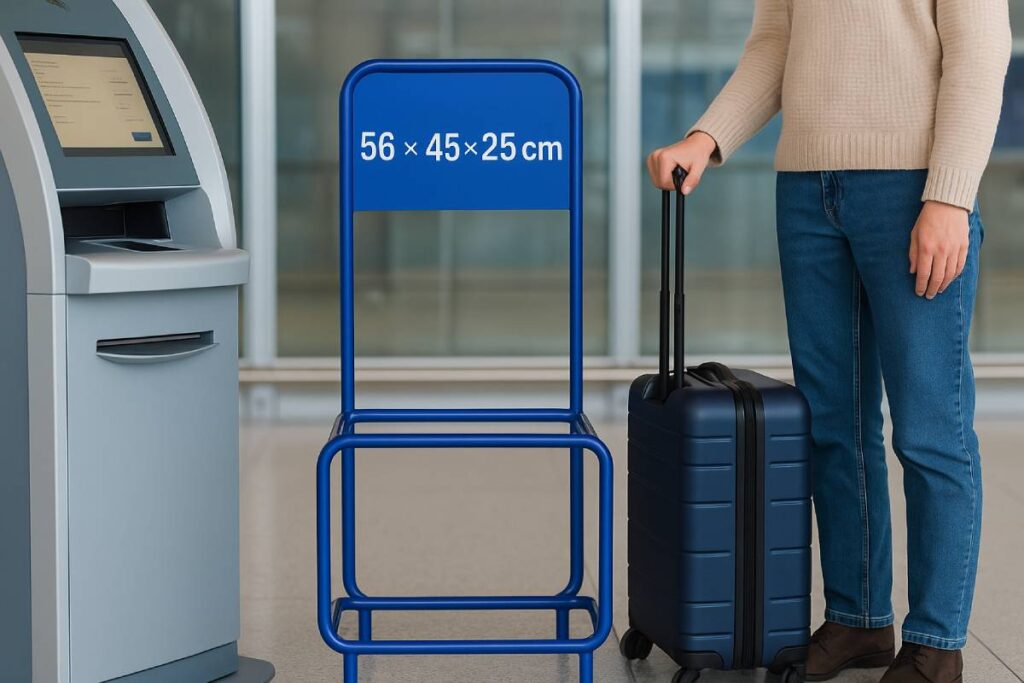
Navigating airline carry-on regulations can be one of the most frustrating parts of pre-travel planning—especially when size limits differ between U.S. domestic standards (22 × 14 × 9 in) and international carriers like Emirates (55 × 38 × 22 cm). While U.S. airlines typically focus solely on dimensions and don’t enforce a weight limit, many international carriers cap cabin bags at 7 kg (or 8 kg on Lufthansa). Personal item allowances—such as 18 × 14 × 8 in on American Airlines—let you pack a small purse or laptop bag under the seat without counting toward your main carry-on.
Size Restrictions
Most U.S. airlines adhere to the FAA’s 22 × 14 × 9 in standard, requiring carry-ons to fit in overhead bins or under seats. In practice, American Airlines, Delta, and United all follow this rule, making U.S. travelers’ lives easier at check-in. International airlines can vary: Emirates limits bags to 55 × 38 × 22 cm (21.6 × 14.9 × 8.6 in), while Lufthansa allows 55 × 40 × 23 cm (21.6 × 15.7 × 9 in).
| Airline | Max Dimensions (incl. handles/wheels) | Weight Limit |
|---|---|---|
| American Airlines | 22 × 14 × 9 in (56 × 36 × 23 cm) | N/A |
| Delta Air Lines | 22 × 14 × 9 in (56 × 35 × 23 cm) | N/A |
| United Airlines | 22 × 14 × 9 in (56 × 35 × 23 cm) | N/A |
| Emirates (Economy) | 55 × 38 × 22 cm (21.6 × 14.9 × 8.6 in) | 7 kg |
| British Airways | 56 × 45 × 25 cm (22 × 18 × 10 in) | 23 kg |
| Lufthansa (Economy) | 55 × 40 × 23 cm (21.6 × 15.7 × 9 in) | 8 kg |
Sources: American Airlines; Delta; United; Emirates; British Airways; Lufthansa.
Weight Restrictions
U.S. carriers generally do not publish a weight limit for carry-ons, trusting passengers to manage size rather than weight at check-in. However, on international routes, many airlines impose a strict cabin bag weight cap—for example, Emirates Economy permits only 7 kg per bag and Lufthansa Economy sets an 8 kg limit.
Tips for weighing at home pre-departure:
- Use a portable luggage scale. Models like the Bagail Digital Luggage Scale hook onto your bag and display weight instantly, so you avoid last-minute surprises at the airport.
- Bathroom-scale method. Weigh yourself alone, then again holding your packed bag; subtract the first figure from the second to find your bag’s weight.
- Redistribute heavy items. If your carry-on edges close to the limit, move boots or books into your personal item (rarely weighed) to even things out.
Personal Item Guidelines
All airlines allow one personal item—typically a purse, laptop bag, or small backpack—that must fit under the seat in front of you . American Airlines caps personal items at 18 × 14 × 8 in (45 × 35 × 20 cm), while United uses a 17 × 10 × 9 in standard, and British Airways allows up to 16 × 12 × 6 in for hand bags. Common acceptable personal items include a laptop sleeve, small camera bag, duty-free shopping bag, or even a collapsible tote for souvenirs.
TSA Security & Liquid Guidelines
TSA’s security screening hinges on the “3-1-1” liquids rule: you may carry liquids, gels and aerosols in containers no larger than 3.4 oz (100 mL) each, all fitting inside one clear, quart-sized, resealable bag—one bag per passenger. Medically necessary liquids (prescription medicines, diabetic drinks) and baby items (formula, breast milk, baby food) are exempt from the size limit but must be declared for separate screening. Conversely, prohibited items—flammable aerosols, large sharp objects, firearms, and certain agricultural products—must remain out of carry-ons. To glide through the checkpoint, pack your quart bag and electronics in accessible pockets, layer items for efficient X-ray visibility, and consider TSA PreCheck for expedited lanes.
The 3-1-1 Rule Explained
The “3-1-1” rule stands for 3.4 oz (100 mL) per container, 1 quart-sized clear bag, and 1 bag per passenger. Each travel-size container—whether it’s shampoo, lotion, or gel—must not exceed 3.4 oz (100 mL) in volume. All of these containers together must fit comfortably in a single, transparent, resealable quart-sized bag; only one such bag is permitted in your carry-on.
Common items subject to the 3-1-1 rule include toothpaste, mouthwash, sunscreen, liquid makeup, and contact-lens solution. Anything in containers larger than 3.4 oz must go into checked baggage to avoid confiscation.
Prohibited & Declared Items
While the 3-1-1 rule governs liquid limits, TSA’s What Can I Bring? database categorizes dozens of items as prohibited or requiring special handling. Below is a snapshot of common banned items alongside key exemptions you can carry if declared:
| Category | Prohibited in Carry-On | Exemptions/Declared Items |
|---|---|---|
| Flammables & Aerosols | Aerosol paint, spray paint, large-cargo aerosols | Medical aerosols (e.g., inhalers) |
| Sharp Objects | Box cutters, ice picks, large knives | Safety razor cartridges (blade enclosed) |
| Firearms & Ammunition | Guns, ammunition, large pepper spray cans | None (must be unloaded, locked, checked) |
| Liquids & Gels | Containers > 3.4 oz | Medically necessary liquids (prescription meds) |
| Baby & Toddler Foods | — | Baby formula, breast milk, juice, baby food (declare) |
| Agricultural Goods | Fresh produce from restricted zones (HI, PR, USVI) | Solid foods (bread, chips, cheese) |
Sources: TSA Liquids Rule; Baby Food Guidelines; What Can I Bring?.
Checkpoint Efficiency Tips
Smooth screening saves you time and stress. Follow these expert packing strategies:
- Front-Pocket Quart Bag: Tuck your 3-1-1 liquids bag into an outer pocket of your carry-on for quick removal and inspection.
- Top-Layer Electronics: Place laptops and tablets at the top of your bag so TSA officers can easily lift them out for separate X-ray screening.
- Clear Packing Pouches: Use transparent, resealable pouches for cords, power banks and small chargers—this speeds up visual checks and avoids tangles.
- Minimalist Organization: Group like-items together—e.g., all chargers in one pouch, all toiletries in another—to streamline any additional searches.
- Consider TSA PreCheck: Enrolling in TSA PreCheck lets you keep on shoes and belts and leave laptops and liquids inside your bag, cutting average screening time in half.
By mastering the 3-1-1 rule, declaring exempted items, and organizing your bag for maximum visibility, you’ll breeze through security and start your trip relaxed and on time.
Essential Carry-On Items by Category
Here’s a detailed breakdown of the must-have carry-on items by category, packed with expert tips and real-world stats to help you travel smarter and stress-free.
Before diving in, remember: having the right items at your fingertips can make the difference between a smooth journey and airport anxiety. From irreplaceable documents to lifesaving snacks, here’s how to cover all bases.
Documents & Travel Essentials
Start with your core paperwork—without these, nothing else matters.
- Passport & Visas: Always keep your passport in an easily accessible pocket; if you need a visa, carry both the stamped page and any approval letters.
- Boarding Passes & Itineraries: Print at least one hard copy of your boarding passes and daily itinerary—digital files can fail when your phone dies.
- Travel Insurance Info: A small laminated card with your policy number and emergency contact can save precious minutes if something goes wrong.
- Money & Credit Cards: Store a backup credit card and some local currency in a separate sleeve of your travel wallet.
Pro Tip
Scan all documents to your phone’s secure cloud folder—if anything is lost or stolen, you’ll have instant access to backups.
Electronics & Tech Gear
Keeping devices charged and organized is critical for both work and play.
- Smartphone & Charger: Your lifeline for boarding passes, maps, and emergency calls—never leave home without them.
- Power Bank: A 10,000 mAh USB-C charger ensures you can top up on the go; TSA requires all power banks in carry-on luggage.
- Headphones/Earbuds: Noise-cancelling models for long hauls, plus a spare pair of earbuds for backup.
- Universal Adapter: One that covers at least two USB ports and fits outlets in 150+ countries—don’t get caught powerless abroad.
Organization Hack
Use a dedicated electronics pouch (like a Dopp kit for tech) to keep cables, adapters, and memory cards neat and visible at security.
Clothing & Accessories
Pack versatile pieces and use smart organizers to maximize space.
Outfit Planning by Trip Length
- 1–3 Days: 2–3 tops, 1 bottom, 3 sets of underwear, 1 pair of socks—mix and match neutrals.
- Week+ Trips: 5 tops, 2 bottoms, 1 light jacket, multi-use scarf—layering covers all weather.
Layering Tips
Roll thin items and fold bulkier layers; layering helps you adjust to both chilly cabins and hot arrivals.
Recommended Packing Cubes
| Brand | Set Size | Features | Pros / Cons |
|---|---|---|---|
| Veken | 6-piece | Includes laundry & shoe bag; lightweight | Highly organized; slightly added bulk |
| Peak Design | 2-piece (Small/Large) | Rigid sides, quick-access zippers | Ultra-durable; fewer size options |
Table 1. Top packing cubes to streamline your wardrobe.
Toiletries & Personal Care
Comply with TSA rules without sacrificing comfort.
- Liquids & Gels (3-1-1 Rule): Containers ≤ 3.4 oz (100 mL) in one clear, quart-size bag per passenger.
- Solid Alternatives: Swap shampoo and soap for travel-friendly bars (solid shampoo, bar soap) to bypass liquid limits.
- Travel-Size vs. Full-Size: Only pack full-size if you’re checking a bag—otherwise stick to travel sizes to stay within carry-on constraints.
- Daily Essentials: Toothbrush, toothpaste, deodorant stick, lip balm, sunscreen (in travel-size container).
Health, Safety & Miscellaneous
Never underestimate the power of preparedness.
- Medications: Prescription drugs in original bottles plus OTC pain relievers (acetaminophen, ibuprofen) in a labeled pouch.
- First-Aid Kit: A compact kit with bandages, gauze, antiseptic wipes, and tweezers—assembled or store-bought.
- Snacks: High-protein, non-perishable options like trail mix, beef jerky, and granola bars to keep energy up during delays.
- Reusable Water Bottle: Bring it empty through security and refill at airport water stations—staying hydrated beats overpriced drinks.
By organizing your carry-on into these five categories, you’ll breeze through security, stay comfortable en route, and avoid the panic of forgotten essentials. Safe travels!
Space-Saving Packing Techniques
Packing efficiently is as much about smart choices as it is about technique. Packing cubes are ideal for organization, keeping your items neatly separated and instantly visible, while compression bags shine at reducing bulk—some claim up to an 80% volume reduction by squeezing out excess air. Packing cubes create modular compartments that protect delicate fabrics and prevent shifting during transit. When it comes to rolling versus folding, rolling can lock in smoothness and minimize wrinkles, whereas folding can yield tidier, flatter stacks that often fit better in rectangular spaces.
Packing Cubes vs. Compression Bags
Benefits of Packing Cubes
- Packing cubes maintain order by keeping outfits separated—ideal for quickly locating items mid-trip.
- They’re perfect for short getaways when you need frequent access to specific pieces without unpacking your entire bag.
Benefits of Compression Bags
- Compression bags excel at squeezing out air to reduce bulk, helping you pack up to 80% more gear in the same volume.
- Their airtight seal also protects contents from moisture, making them a smart choice for checked luggage or rainy destinations.
When to Use Each
- Use packing cubes when organization and accessibility matter most—weekend escapes, business trips, or family vacations where rapid unpacking is key.
- Use compression bags for longer journeys or when trying to fit bulky items (like jackets or sweaters) into limited spaces, especially if you’re okay with a single compressed mass.
Rolling vs. Folding
Rolling
- Rolling clothes creates tight cylinders that often reduce wrinkles more effectively than haphazard folding.
- For wrinkle-prone fabrics, smooth out creases first, fold along seams, then roll to lock in a flatter profile.
Folding
- Folding yields flatter, stackable layers that can sometimes make better use of a bag’s rectangular shape.
- Structured garments—blazers, dress shirts, or anything with stiff collars—benefit from folding along natural lines to preserve form.
Hybrid Approach
- Combine both methods: fold formal or structured pieces (blazers, button-downs) to maintain shape, and roll tees, leggings, and casual wear to maximize space and reduce creases.
Layering & Modular Packing
Layering for Access
- Place your most-used items—passport pouch, phone charger, or a light sweater—on top for grab-and-go convenience.
Modular Packing
- Employ clear or labeled pouches (modular kits) dedicated to categories like electronics, underwear, or toiletries; this keeps everything in place and speeds up security checks.
Kit Approach
- Adopt a “kit” mindset: one pouch for grooming supplies, one for tech accessories, and one for first-aid essentials—this prevents rummaging and ensures nothing gets left behind.
Visual Organization
- Using transparent or mesh-fronted organizers lets you immediately spot what you need without emptying the entire cube or bag.
By mastering these space-saving techniques—choosing the right tools, mixing rolling and folding, and implementing modular kits—you’ll optimize every cubic inch of your carry-on and travel with confidence.
Destination & Seasonal Considerations
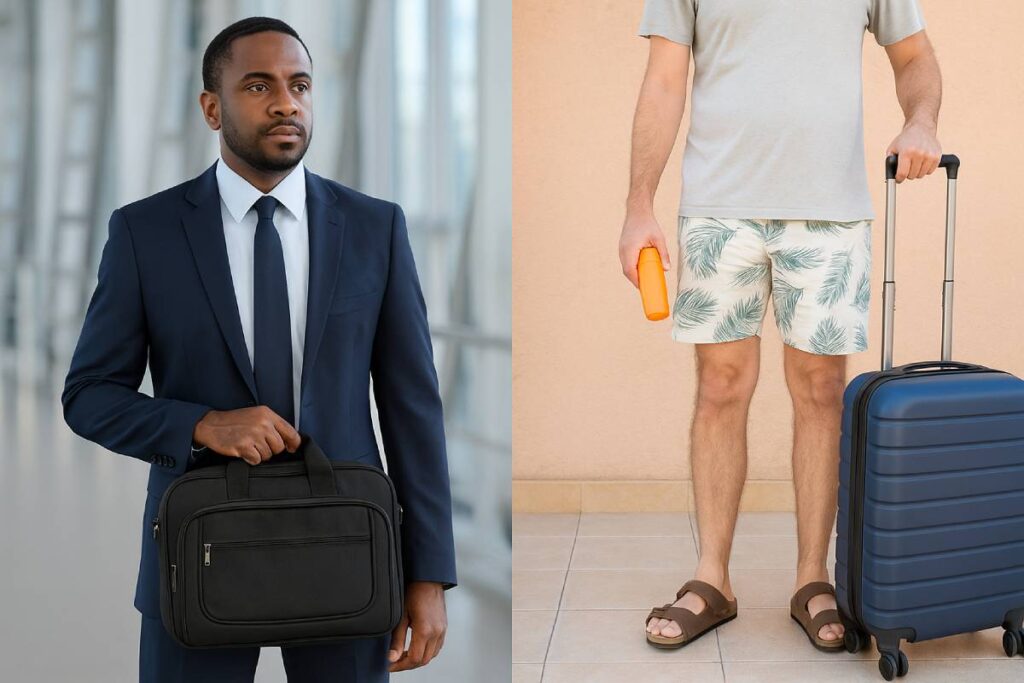
Below is a comprehensive guide to destination and seasonal packing considerations—whether you’re boarding for a boardroom meeting or beachside retreat, gearing up for snow or sunshine, or tailoring your strategy to a weekend jaunt versus an extended stay.
Key Findings: Business travelers prioritize wrinkle-resistant, mix-and-match wardrobe staples and tech essentials, whereas leisure travelers lean into comfort and versatility with casual layers. Packing for cold climates means thermal base layers and insulated outerwear; warm destinations call for moisture-wicking fabrics and sun protection; transitional trips demand modular layering pieces. For a 1–3 day jaunt, a single backpack with 3× outfits often suffices; week-long trips fit neatly into a carry-on; longer voyages benefit from the 5-4-3-2-1 rule—5 tops, 4 bottoms, 3 shoes, 2 accessories, 1 dress or jacket.
Business vs. Leisure Travel
When traveling for work, your carry-on doubles as a mobile office: think tailored blazers, wrinkle-resistant dress shirts, and neutral trousers that mix and match easily. A capsule wardrobe—two versatile tops, one blazer, one pant—can serve boardroom and after-hours events with minimal bulk. In contrast, leisure travelers prioritize comfort: soft tees, lounge shorts, and casual sneakers. Fabrics like merino wool and performance blends offer odor resistance and quick-drying properties, ideal for sightseeing or beach days.
| Feature | Business Travel | Leisure Travel |
|---|---|---|
| Wardrobe | Tailored, neutral, wrinkle-resistant pieces | Casual, comfortable, mix-and-match styles |
| Accessories | Tech organizer, portable steamer, tie clip | Sunhat, sunglasses, foldable tote |
| Bag Style | Structured carry-on (e.g., roller with suit compartment) | Soft duffel or backpack for flexibility |
| Key Mindset | Professional presentation | Comfort and versatility |
Climate & Activity Planning
Packing by climate ensures you’re prepared without overloading your bag. Layering is your best friend for variable conditions, while specialized gear protects against the elements.
| Climate Type | Typical Temps | Must-Pack Items |
|---|---|---|
| Cold (<50 °F/10 °C) | –10 °F to 50 °F | Thermal base layers, wool sweater, insulated jacket, gloves, beanie |
| Warm (>70 °F/21 °C) | 70 °F to 100 °F | Breathable tees, shorts, sun hat, UV-blocking sunglasses, lightweight rain shell |
| Mixed/Transitional | Varies throughout day | Light sweater, cardigan, scarf, waterproof shell, convertible pants |
Activity add-ons:
- Beach: Quick-dry towel, reef-safe sunscreen, water shoes.
- City Sightseeing: Comfortable walking shoes, compact umbrella, daypack.
- Outdoor Adventure: Hiking socks, moisture-wicking base layer, portable water filter.
Trip Duration Adjustments
Your packing footprint should scale with trip length. Adopting minimalist principles for short trips and a modular expansion for longer stays keeps your carry-on optimized.
| Trip Length | Bag Recommendation | Clothing Formula |
|---|---|---|
| 1–3 days | Small backpack or daypack | Wear Day 1 outfit on plane; pack 2× rolled tops, 1× bottom, 3× undergarments |
| 4–7 days | Standard carry-on | 5 tops, 3 bottoms, 1 light jacket; use cubes to separate by outfit |
| 8+ days | Carry-on + checked bag | Follow “5-4-3-2-1” rule: 5 tops, 4 bottoms, 3 pairs shoes, 2 accessories, 1 jacket/dress |
Expert Tips:
- Layer wear: Don your bulkiest items (jacket, boots) on travel days to free up space.
- Use versatile pieces: A scarf or lightweight pashmina can serve as a blanket, accessory, or extra layer.
- Laundry on the go: Packing a small laundry soap sheet lets you refresh basics mid-trip.
By aligning your packing strategy with travel purpose, climate demands, and trip length, you’ll maximize carry-on efficiency, stay organized, and enjoy more freedom—no matter where your journey takes you.
Interactive & Downloadable Checklist
Travelers today expect seamless, multi-format checklists that they can print, edit online, or pull up instantly on their phones. Free, printable PDFs from trusted sites like SmarterTravel’s Ultimate Packing List and Just a Girl and Her Blog see thousands of downloads each month, while interactive Google Sheets templates—installed over 84,000 times via Travel Mapper—let users toggle items in real time. Embedding these sheets on your site is as simple as “Publish to web” in Google Docs. Finally, dynamic QR codes (from services like QRCode Monkey and MyQRCode) transform any static page into a mobile-friendly, on-the-go reference, ensuring your checklist is never more than a scan away.
Printable PDF Version
A printable PDF remains the gold standard for travelers who prefer pen-and-paper reassurance or need offline access. By downloading our curated PDF—modeled on SmarterTravel’s interactive template—you get:
- Complete, categorized layout with checkboxes for Documents, Electronics, Clothing, Toiletries, and more
- High-contrast design optimized for quick scanning at home or in airport lounges
- Easy annotation, letting you jot in trip-specific items without cluttering the main list
<a href=”https://emoblya.com/assets/carry-on-checklist.pdf” download style=”display:inline-block;padding:12px 20px;background:#0073e6;color:#fff;border-radius:4px;text-decoration:none;”>Download Printable PDF</a>
Online Interactive Checklist
Embed a live, editable checklist on your blog or site so readers can track packing progress in real time. Here’s how to compare top platforms:
| Platform | Key Features | Integration |
|---|---|---|
| Google Sheets | Real-time editing, shareable link, automatic syncing | Embed via “Publish to web” |
| Travel Mapper | Ready-made travel checklist template, map integration | Install add-on; embed iframe |
| Reddit Template | Dynamic weight calculations, customizable items | Share “View only” link |
| Custom Widget | White-label checklist tool with progress bars | JavaScript snippet |
How to embed a Google Sheet:
- In Google Sheets, click File → Share → Publish to web.
- Choose Embed and copy the
<iframe>code. - Paste into your site’s HTML where you want the checklist to appear.
Mobile-Friendly Reference
Ensure your checklist travels as light as you do. Generate a QR code that links directly to either the PDF or interactive sheet—no typing required.
| QR Service | Highlights | Export Formats |
|---|---|---|
| QRCode Monkey | High-res vector (SVG, EPS, PDF); logo & color customization | PNG, SVG, PDF |
| MyQRCode | Itinerary & checklist URL linking; analytics option | PNG, SVG |
| QR Code Dynamic | Dynamic content updates without reprinting | PNG, JPG |
| Axonator QR App | Enterprise-grade checklist management, offline support | App-based link |
Implementation Steps:
- Choose your URL (PDF link or Google Sheets embed).
- Generate the QR code using any of the above services.
- Place the QR in your blog post, social share image, or printed handout—traveler’s scan, checklist appears instantly.
By offering a printable PDF, an interactive online sheet, and a mobile-first QR code, you cover every user preference—boosting engagement, time on page, and shares. Encourage readers to download, track, and scan for a truly seamless packing experience.
How to Store Digital and Physical Copies of Important Contacts
Travel experts agree that a multi-layered approach to storing emergency contacts and sharing itineraries is essential for safety and peace of mind. By combining encrypted digital backups, physical printouts, and real-time sharing with trusted contacts, you minimize risks and ensure help can find you if needed.
Digital Storage
- Cloud Services: Upload scanned copies of passports, visas, and emergency contacts to secure cloud drives like Google Drive or Dropbox. This ensures you can retrieve documents even if your device is lost or stolen.
- Encrypted USB Flash Drive: Carry a small, password-protected USB drive partitioned and encrypted. Store text files with emergency contacts, medical info, and scanned IDs for offline access.
- Email & Drafts: Email yourself a zip file of all key documents or save drafts containing scans. Email accounts are unlikely to be deleted mid-trip, providing an immutable backup.
- Travel Apps (e.g., TripIt): Use TripIt’s Traveler Profile to store digital contact cards, passport scans, and medical details behind a secure PIN—accessible via iOS, Android, or web.
Physical Storage
- Printed Contact List: Print a one-page emergency contact list (family, embassy, insurance) and tuck it into your travel wallet or organizer.
- Document Organizer: Use a zip-pocket travel organizer or PVC emergency wallet card to keep photocopies of passports and contacts separate from your originals.
| Storage Type | Medium/Tool | Security Feature |
|---|---|---|
| Cloud | Google Drive/Dropbox | SSL encryption; two-factor auth |
| Encrypted USB Drive | Hardware flash drive | AES-256 encryption; PIN lock |
| Email Drafts | Gmail/Outlook | Email server redundancy |
| TripIt App | TripIt Traveler Profile | PIN-protected; app-level security |
| Printed Copies | Paper printout | Physical separation; hidden pocket |
| PVC Emergency Card | Wallet card | Durable, waterproof; visible info |
Sharing Itinerary with Friends or Family
Why Share Your Itinerary?
- Safety Net: A trusted person with your full travel plan can alert authorities if you miss check-ins, speeding up assistance .
- Peace of Mind: Knowing someone else has your detailed schedule reduces anxiety for both you and your loved ones.
Methods of Sharing
| Method | Platform/Tool | Access & Features |
|---|---|---|
| Email Attachment | Gmail/Outlook | Universal access; offline download |
| Google Docs | Google Docs (shared link) | Live edits; permission controls |
| Google My Maps | Custom Google Map share | Visual route planning; real-time updates |
| TripIt Sharing | TripIt itinerary share | Auto-updates; email notifications |
| Messaging Apps | WhatsApp/Signal | Quick link share; encryption |
Best Practices
- Include All Details: Flights (numbers, times), accommodations (addresses, check-in/out), transport bookings, and daily activities.
- Set Check-In Times: Agree on regular check-in intervals. If missed, your contact knows to initiate your emergency plan.
- Use Permission Controls: With Google Docs or Maps, restrict editing to yourself and viewing to trusted contacts. Change permissions if plans shift.
- Backup Copies: Ask your contact to print a copy of your itinerary or save it offline on their device.
By combining secure digital and physical document storage with proactive itinerary sharing, you create multiple safety nets—ensuring help can find you swiftly and giving both you and your loved ones greater peace of mind.
Conclusion
By now, you’ve seen that carry-on mastery starts with clear guidelines: adhere to IATA’s 56 × 45 × 25 cm recommendation and be mindful of airline-specific tweaks. TSA’s 3-1-1 liquids rule keeps the checkpoint swift and safe—just one quart-size bag of 3.4 oz containers per person.
Categorizing items (documents, electronics, clothing, toiletries, health kit) guarantees you never scramble at security, and space-saving tools like compression bags (up to 80 % bulk reduction) and packing cubes streamline organization. Rolling vs. folding and modular layering empower you to adapt to weather shifts, activity needs, and trip duration without overpacking.
Offering your audience a printable PDF (downloaded thousands of times on SmarterTravel) alongside an online interactive checklist (used by over 84,000 Travel Mapper users) and a mobile-ready QR code covers every traveler’s preference. Finally, securing digital and physical copies of contacts and sharing your itinerary with trusted friends delivers peace of mind—because the best journeys are the ones you start prepared.
FAQs
What are the universally accepted carry-on dimensions?
Most airlines follow IATA’s guideline of 56 × 45 × 25 cm (22 × 18 × 10 in), but always double-check your carrier’s policy.
How strict is TSA about liquids?
TSA enforces the 3-1-1 rule: containers ≤ 100 mL (3.4 oz) in one quart-size clear bag, one bag per passenger.
Do compression bags harm my clothes?
Natural fibers rebound nicely, but structured garments (blazers) may crease—use selectively for bulky items.
Can I share my packing checklist?
Yes—use our interactive Google Sheet for real-time collaboration or send the downloadable PDF to friends.

